Alejandro C. Frery
A PolSAR Scattering Power Factorization Framework and Novel Roll-Invariant Parameters Based Unsupervised Classification Scheme Using a Geodesic Distance
Jun 27, 2019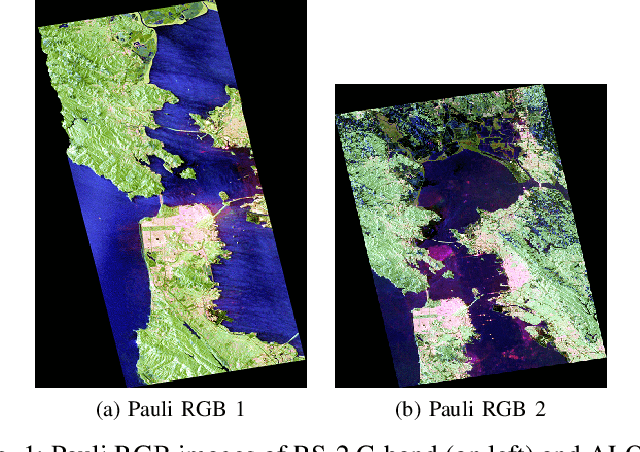


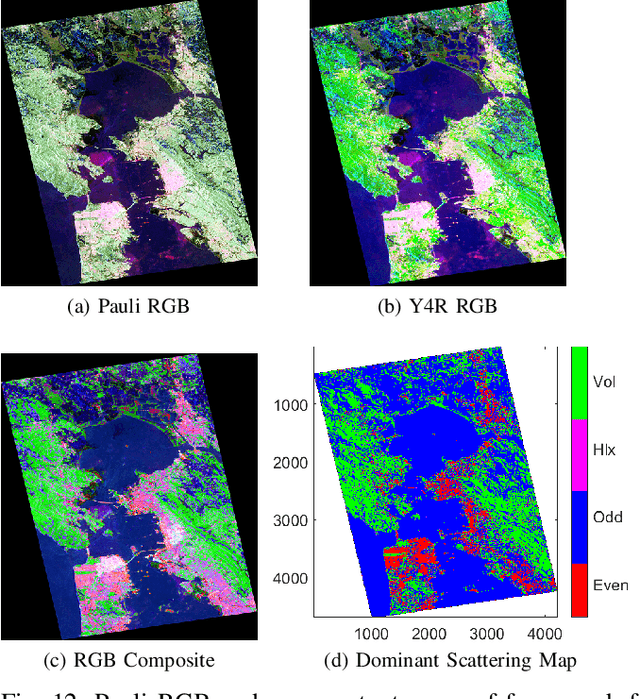
Abstract:We propose a generic Scattering Power Factorization Framework (SPFF) for Polarimetric Synthetic Aperture Radar (PolSAR) data to directly obtain $N$ scattering power components along with a residue power component for each pixel. Each scattering power component is factorized into similarity (or dissimilarity) using elementary targets and a generalized random volume model. The similarity measure is derived using a geodesic distance between pairs of $4\times4$ real Kennaugh matrices. In standard model-based decomposition schemes, the $3\times3$ Hermitian positive semi-definite covariance (or coherency) matrix is expressed as a weighted linear combination of scattering targets following a fixed hierarchical process. In contrast, under the proposed framework, a convex splitting of unity is performed to obtain the weights while preserving the dominance of the scattering components. The product of the total power (Span) with these weights provides the non-negative scattering power components. Furthermore, the framework along the geodesic distance is effectively used to obtain specific roll-invariant parameters which are then utilized to design an unsupervised classification scheme. The SPFF, the roll invariant parameters, and the classification results are assessed using C-band RADARSAT-2 and L-band ALOS-2 images of San Francisco.
Comparing Samples from the $\mathcal{G}^0$ Distribution using a Geodesic Distance
Apr 23, 2019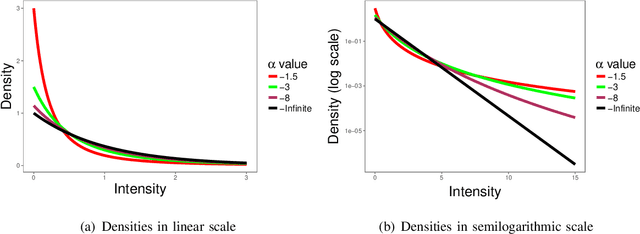
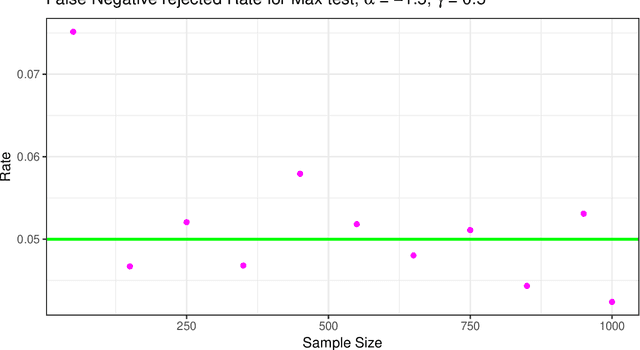
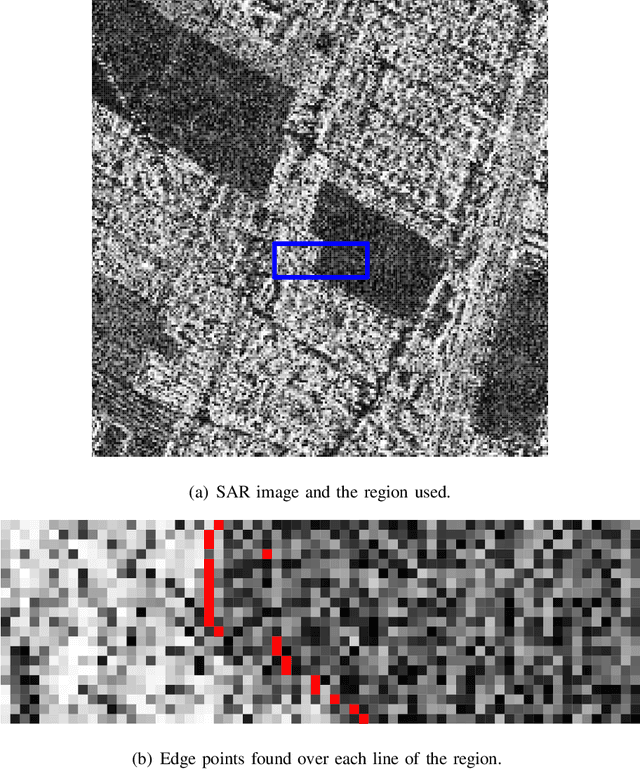
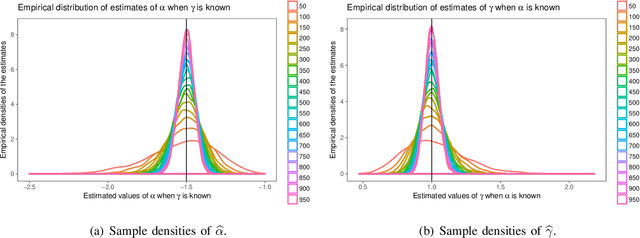
Abstract:The $\mathcal{G}^0$ distribution is widely used for monopolarized SAR image modeling because it can characterize regions with different degree of texture accurately. It is indexed by three parameters: the number of looks (which can be estimated for the whole image), a scale parameter and a texture parameter. This paper presents a new proposal for comparing samples from the $\mathcal{G}^0$ distribution using a Geodesic Distance (GD) as a measure of dissimilarity between models. The objective is quantifying the difference between pairs of samples from SAR data using both local parameters (scale and texture) of the $\mathcal{G}^0$ distribution. We propose three tests based on the GD which combine the tests presented in~\cite{GeodesicDistanceGI0JSTARS}, and we estimate their probability distributions using permutation methods.
Parameter Estimation for the Single-Look $\mathcal{G}^0$ Distribution
Sep 29, 2018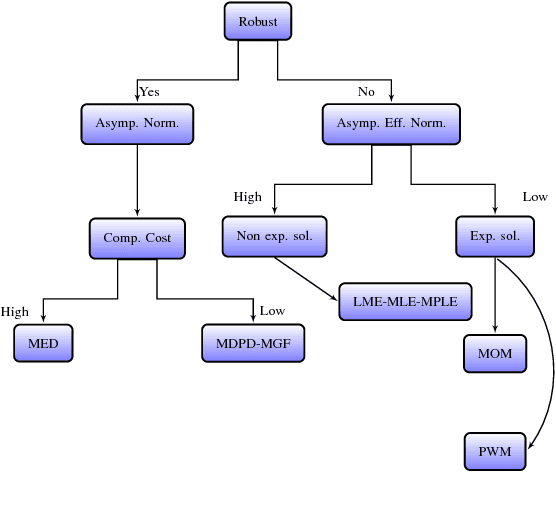


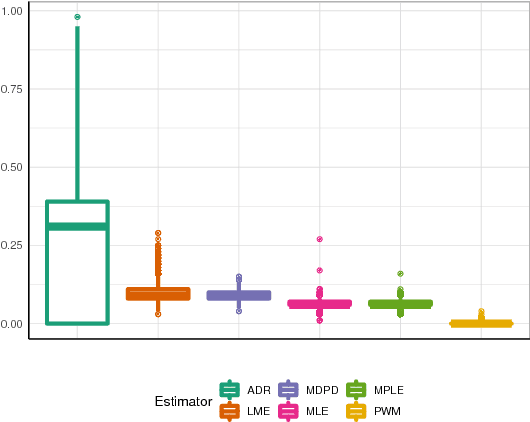
Abstract:The statistical properties of Synthetic Aperture Radar (SAR) image texture reveals useful target characteristics. It is well-known that these images are affected by speckle, and prone to contamination as double bounce and corner reflectors. The $\mathcal{G}^0$ distribution is flexible enough to model different degrees of texture in speckled data. It is indexed by three parameters: $\alpha$, related to the texture, $\gamma$, a scale parameter, and $L$, the number of looks which is related to the signal-to-noise ratio. Quality estimation of $\alpha$ is essential due to its immediate interpretability. In this article, we compare the behavior of a number of parameter estimation techniques in the noisiest case, namely single look data. We evaluate them using Monte Carlo methods for non-contaminated and contaminated data, considering convergence rate, bias, mean squared error (MSE) and computational cost. The results are verified with simulated and actual SAR images.
Unsupervised Classification of PolSAR Data Using a Scattering Similarity Measure Derived from a Geodesic Distance
Dec 01, 2017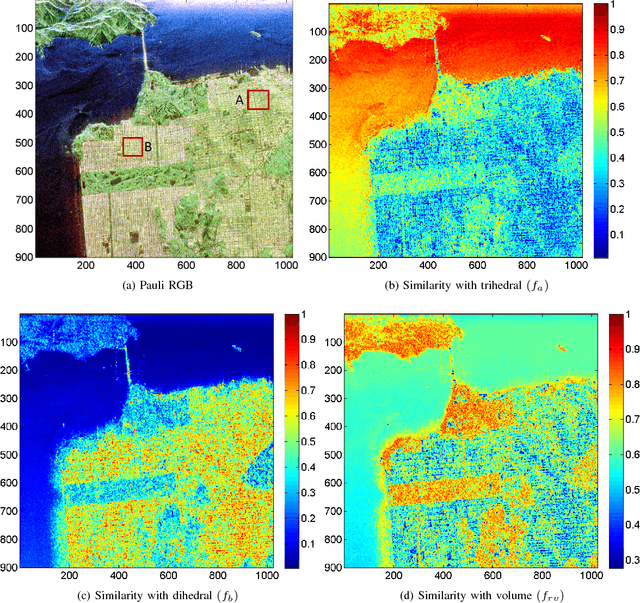
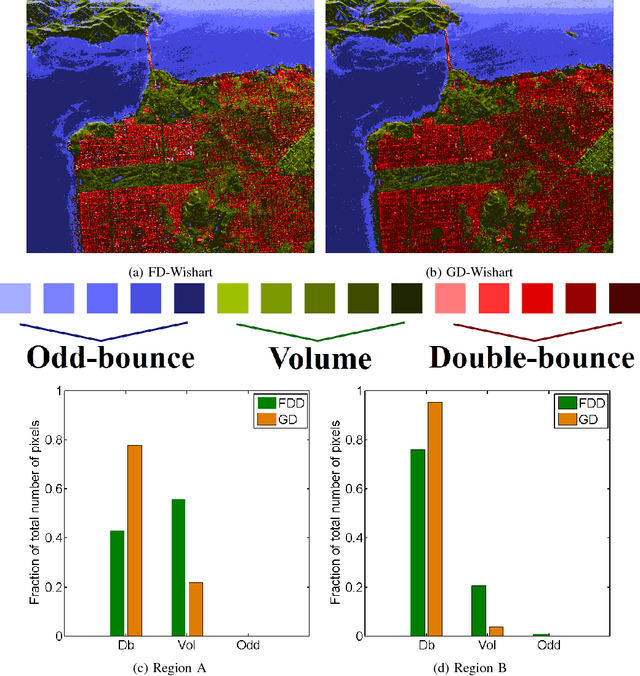

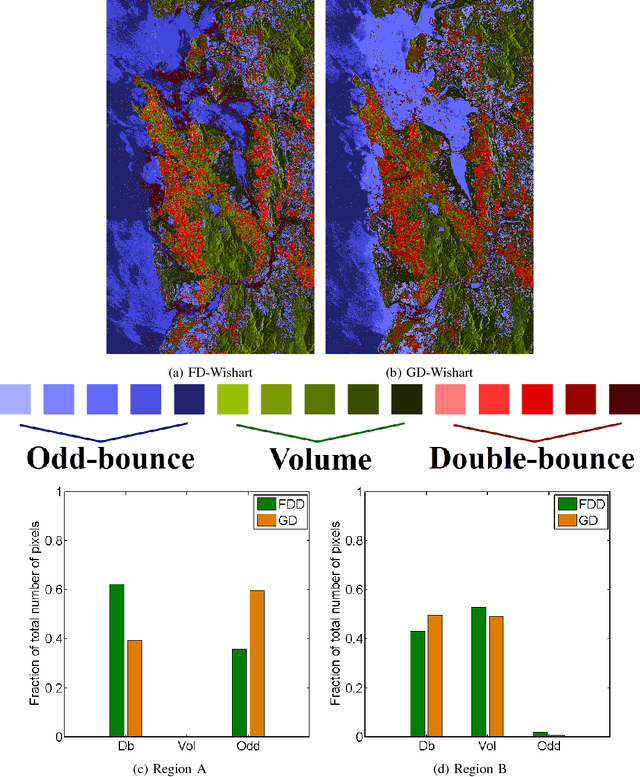
Abstract:In this letter, we propose a novel technique for obtaining scattering components from Polarimetric Synthetic Aperture Radar (PolSAR) data using the geodesic distance on the unit sphere. This geodesic distance is obtained between an elementary target and the observed Kennaugh matrix, and it is further utilized to compute a similarity measure between scattering mechanisms. The normalized similarity measure for each elementary target is then modulated with the total scattering power (Span). This measure is used to categorize pixels into three categories i.e. odd-bounce, double-bounce and volume, depending on which of the above scattering mechanisms dominate. Then the maximum likelihood classifier of [J.-S. Lee, M. R. Grunes, E. Pottier, and L. Ferro-Famil, Unsupervised terrain classification preserving polarimetric scattering characteristics, IEEE Trans. Geos. Rem. Sens., vol. 42, no. 4, pp. 722731, April 2004.] based on the complex Wishart distribution is iteratively used for each category. Dominant scattering mechanisms are thus preserved in this classification scheme. We show results for L-band AIRSAR and ALOS-2 datasets acquired over San Francisco and Mumbai, respectively. The scattering mechanisms are better preserved using the proposed methodology than the unsupervised classification results using the Freeman-Durden scattering powers on an orientation angle (OA) corrected PolSAR image. Furthermore, (1) the scattering similarity is a completely non-negative quantity unlike the negative powers that might occur in double- bounce and odd-bounce scattering component under Freeman Durden decomposition (FDD), and (2) the methodology can be extended to more canonical targets as well as for bistatic scattering.
Unassisted Quantitative Evaluation Of Despeckling Filters
Apr 19, 2017



Abstract:SAR (Synthetic Aperture Radar) imaging plays a central role in Remote Sensing due to, among other important features, its ability to provide high-resolution, day-and-night and almost weather-independent images. SAR images are affected from a granular contamination, speckle, that can be described by a multiplicative model. Many despeckling techniques have been proposed in the literature, as well as measures of the quality of the results they provide. Assuming the multiplicative model, the observed image $Z$ is the product of two independent fields: the backscatter $X$ and the speckle $Y$. The result of any speckle filter is $\widehat X$, an estimator of the backscatter $X$, based solely on the observed data $Z$. An ideal estimator would be the one for which the ratio of the observed image to the filtered one $I=Z/\widehat X$ is only speckle: a collection of independent identically distributed samples from Gamma variates. We, then, assess the quality of a filter by the closeness of $I$ to the hypothesis that it is adherent to the statistical properties of pure speckle. We analyze filters through the ratio image they produce with regards to first- and second-order statistics: the former check marginal properties, while the latter verifies lack of structure. A new quantitative image-quality index is then defined, and applied to state-of-the-art despeckling filters. This new measure provides consistent results with commonly used quality measures (equivalent number of looks, PSNR, MSSIM, $\beta$ edge correlation, and preservation of the mean), and ranks the filters results also in agreement with their visual analysis. We conclude our study showing that the proposed measure can be successfully used to optimize the (often many) parameters that define a speckle filter.
The Geodesic Distance between $\mathcal{G}_I^0$ Models and its Application to Region Discrimination
Jan 01, 2017
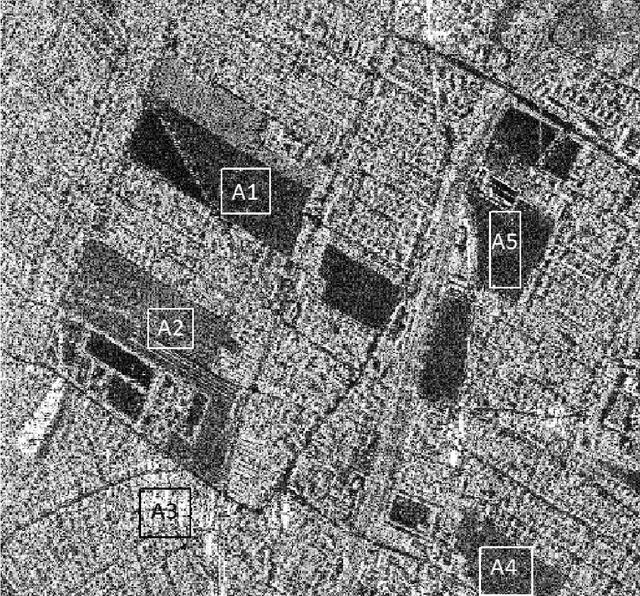
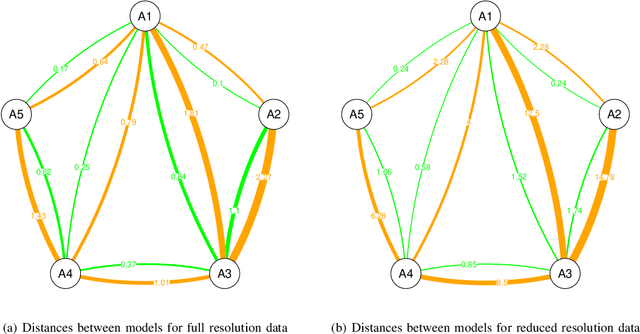
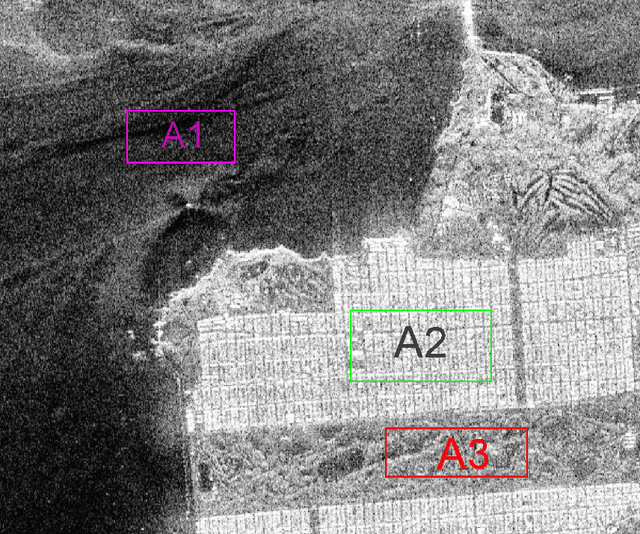
Abstract:The $\mathcal{G}_I^0$ distribution is able to characterize different regions in monopolarized SAR imagery. It is indexed by three parameters: the number of looks (which can be estimated in the whole image), a scale parameter and a texture parameter. This paper presents a new proposal for feature extraction and region discrimination in SAR imagery, using the geodesic distance as a measure of dissimilarity between $\mathcal{G}_I^0$ models. We derive geodesic distances between models that describe several practical situations, assuming the number of looks known, for same and different texture and for same and different scale. We then apply this new tool to the problems of (i)~identifying edges between regions with different texture, and (ii)~quantify the dissimilarity between pairs of samples in actual SAR data. We analyze the advantages of using the geodesic distance when compared to stochastic distances.
Classification and Verification of Online Handwritten Signatures with Time Causal Information Theory Quantifiers
Jan 26, 2016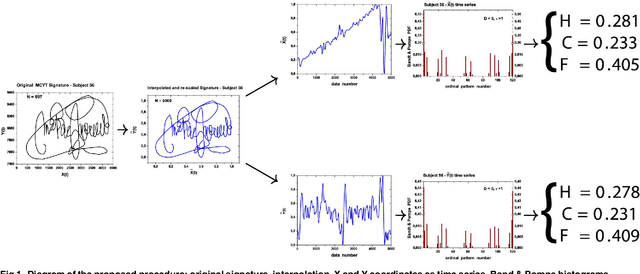
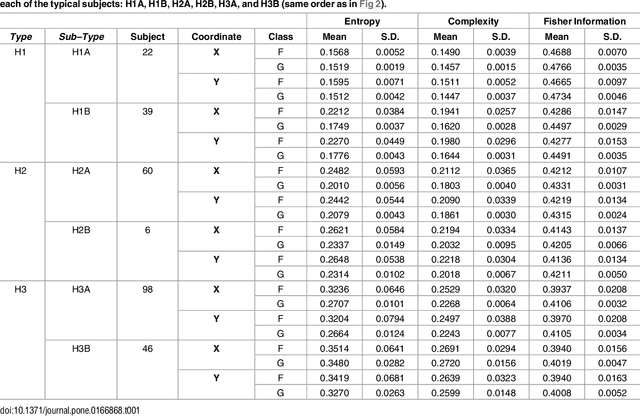
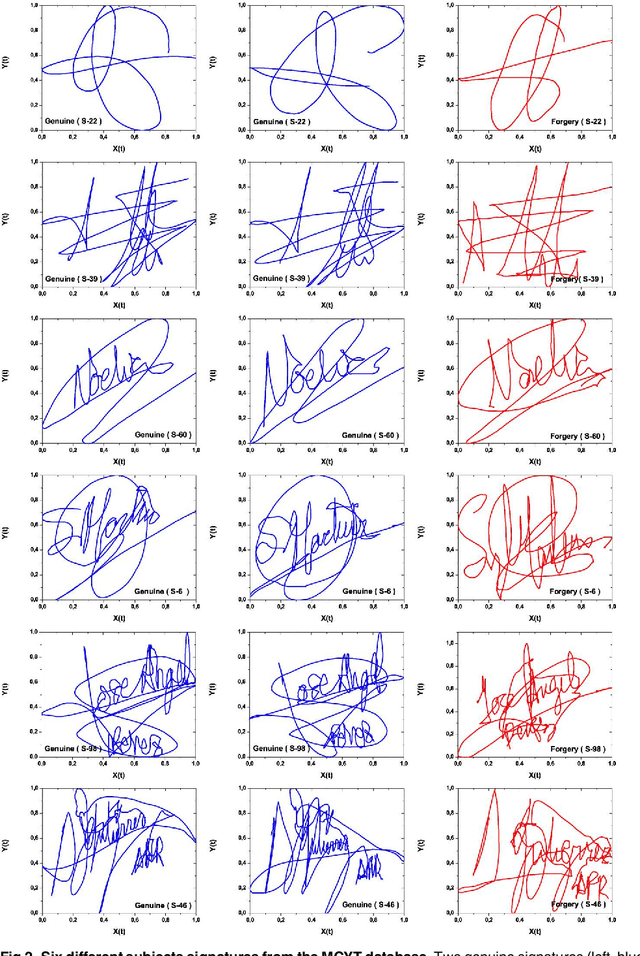

Abstract:We present a new approach for online handwritten signature classification and verification based on descriptors stemming from Information Theory. The proposal uses the Shannon Entropy, the Statistical Complexity, and the Fisher Information evaluated over the Bandt and Pompe symbolization of the horizontal and vertical coordinates of signatures. These six features are easy and fast to compute, and they are the input to an One-Class Support Vector Machine classifier. The results produced surpass state-of-the-art techniques that employ higher-dimensional feature spaces which often require specialized software and hardware. We assess the consistency of our proposal with respect to the size of the training sample, and we also use it to classify the signatures into meaningful groups.
Optical images-based edge detection in Synthetic Aperture Radar images
Aug 24, 2015



Abstract:We address the issue of adapting optical images-based edge detection techniques for use in Polarimetric Synthetic Aperture Radar (PolSAR) imagery. We modify the gravitational edge detection technique (inspired by the Law of Universal Gravity) proposed by Lopez-Molina et al, using the non-standard neighbourhood configuration proposed by Fu et al, to reduce the speckle noise in polarimetric SAR imagery. We compare the modified and unmodified versions of the gravitational edge detection technique with the well-established one proposed by Canny, as well as with a recent multiscale fuzzy-based technique proposed by Lopez-Molina et Alejandro We also address the issues of aggregation of gray level images before and after edge detection and of filtering. All techniques addressed here are applied to a mosaic built using class distributions obtained from a real scene, as well as to the true PolSAR image; the mosaic results are assessed using Baddeley's Delta Metric. Our experiments show that modifying the gravitational edge detection technique with a non-standard neighbourhood configuration produces better results than the original technique, as well as the other techniques used for comparison. The experiments show that adapting edge detection methods from Computational Intelligence for use in PolSAR imagery is a new field worthy of exploration.
Classification of Complex Wishart Matrices with a Diffusion-Reaction System guided by Stochastic Distances
Jul 17, 2015
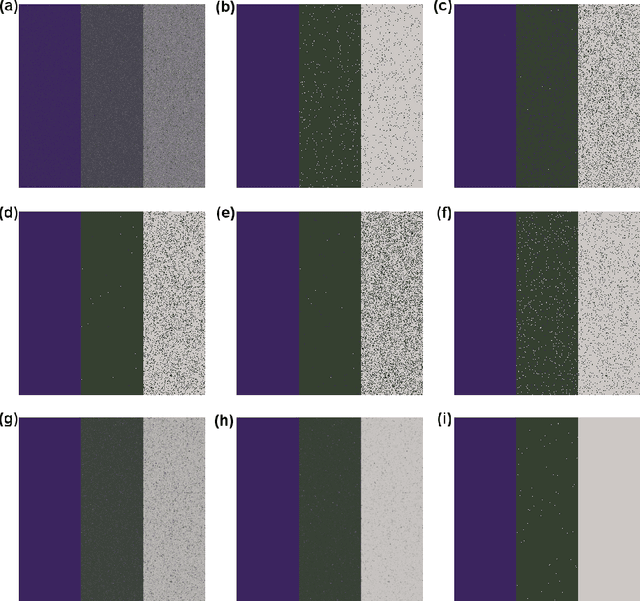
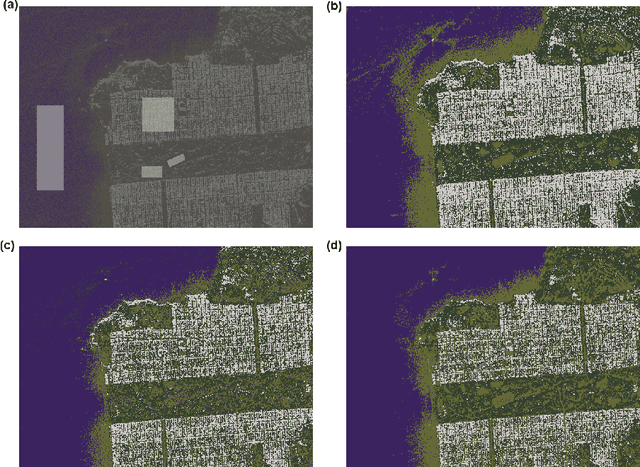
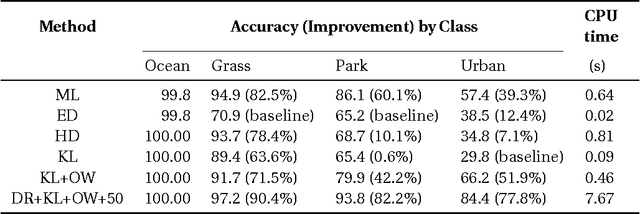
Abstract:We propose a new method for PolSAR (Polarimetric Synthetic Aperture Radar) imagery classification based on stochastic distances in the space of random matrices obeying complex Wishart distributions. Given a collection of prototypes $\{Z_m\}_{m=1}^M$ and a stochastic distance $d(.,.)$, we classify any random matrix $X$ using two criteria in an iterative setup. Firstly, we associate $X$ to the class which minimizes the weighted stochastic distance $w_md(X,Z_m)$, where the positive weights $w_m$ are computed to maximize the class discrimination power. Secondly, we improve the result by embedding the classification problem into a diffusion-reaction partial differential system where the diffusion term smooths the patches within the image, and the reaction term tends to move the pixel values towards the closest class prototype. In particular, the method inherits the benefits of speckle reduction by diffusion-like methods. Results on synthetic and real PolSAR data show the performance of the method.
Bias Correction and Modified Profile Likelihood under the Wishart Complex Distribution
Apr 18, 2014



Abstract:This paper proposes improved methods for the maximum likelihood (ML) estimation of the equivalent number of looks $L$. This parameter has a meaningful interpretation in the context of polarimetric synthetic aperture radar (PolSAR) images. Due to the presence of coherent illumination in their processing, PolSAR systems generate images which present a granular noise called speckle. As a potential solution for reducing such interference, the parameter $L$ controls the signal-noise ratio. Thus, the proposal of efficient estimation methodologies for $L$ has been sought. To that end, we consider firstly that a PolSAR image is well described by the scaled complex Wishart distribution. In recent years, Anfinsen et al. derived and analyzed estimation methods based on the ML and on trace statistical moments for obtaining the parameter $L$ of the unscaled version of such probability law. This paper generalizes that approach. We present the second-order bias expression proposed by Cox and Snell for the ML estimator of this parameter. Moreover, the formula of the profile likelihood modified by Barndorff-Nielsen in terms of $L$ is discussed. Such derivations yield two new ML estimators for the parameter $L$, which are compared to the estimators proposed by Anfinsen et al. The performance of these estimators is assessed by means of Monte Carlo experiments, adopting three statistical measures as comparison criterion: the mean square error, the bias, and the coefficient of variation. Equivalently to the simulation study, an application to actual PolSAR data concludes that the proposed estimators outperform all the others in homogeneous scenarios.
 Add to Chrome
Add to Chrome Add to Firefox
Add to Firefox Add to Edge
Add to Edge